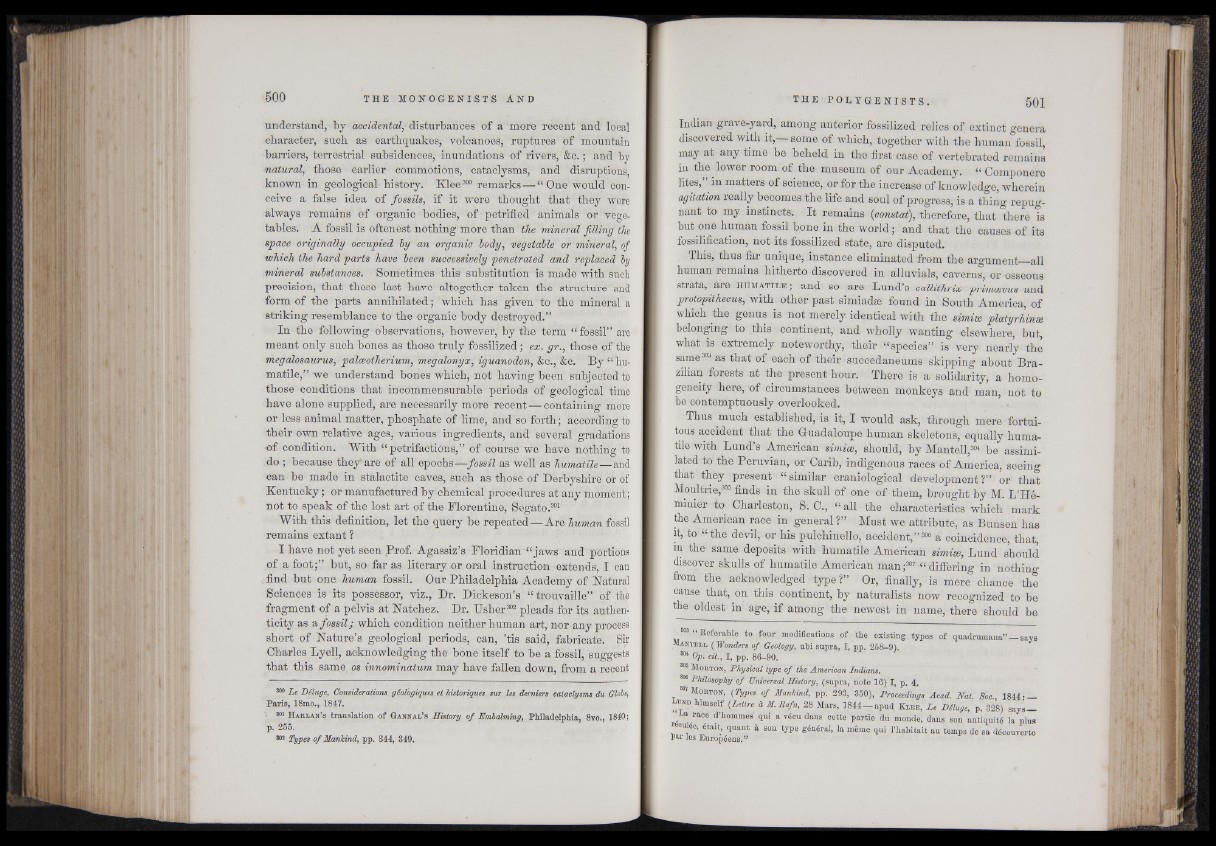
understand, by accidental, disturbances of a more recent and local
character, such as earthquakes, volcanoes, ruptures of mountain
barriers, terrestrial subsidences, inundations of rivers, &c.; and by
natural, those earlier commotions, cataclysms, and disruptions,
known in geological history. Klee300 remarks— “ One would conceive
a false idea of fossils, if it were thought that they were
always remains of organic bodies, of petrified animals or vegetables.
A fossil is oftenest nothing more than the mineral filling the
space originally occupied by an organic body, vegetable or mineral, of
which the hard parts have been successively penetrated and replaced by
mineral substances. Sometimes this substitution is made with suet
precision, that these last have altogether taken the structure and
form of the parts annihilated; which has given to the mineral a
striking resemblance to the organic body destroyed.”
In the following observations, however, by the term “ fossil” are
meant only such bones as those truly fossilized; ex. gr., those'of the
megalosaurus, palceotherium, megalonyx, iguanodon, &e., &c. By “ hu-
matile,” we understand bones which, not having been subjected to
those conditions that incommensurable periods of geological time
have alone supplied, are necessarily more recent — containing more
or less animal matter, phosphate of lime, and so forth; according to
their own relative ages, various ingredients, and several gradations
of condition. With “ petrifactions,” of course we have nothing to
do ; because they1 are of all epochs—fossil as well as humatilel^9and
can be made in stalactite caves, such as those of Derbyshire or of
Kentucky; or manufactured by chemical procedures at any moment;
not to speak of the lost art of the Florentine, Segato.301
With this definition, let the query be repeated—Are human fossil
remains extant ?
I have not yet seen Prof. Agassiz’s Floridian “jaws and portions
of a foot;” but, so far as literary or oral instruction extends, I can
find but one human fossil. Our Philadelphia Academy of Natural
Sciences is its possessor, viz., Dr. Dickeson’s “ trouvaille” of the
fragment of a pelvis at Natchez. Dr. "Usher302 pleads for its authenticity
as a, fossil; which condition neither human art, nor any process
short of Nature’s geological periods, can, ’tis said, fabricate. Sit
Charles Lyell, acknowledging the bone itself to be a fossil, suggests
that this same os innominatum may have fallen down, from a recent
800 Le Deluge, Considerations gCol'ogiques et historiques but les derniers cataclysms du Globe,
Paris, 18mo., 1847.
■ 801 H a b l a n ’s translation of G a n h a l ’s History of Embalming, Philadelphia, 8vo., 1840;
p. 255.
802 types of Mankind, pp. 344, 349.
Indian grave-yard, among anterior fossilized relics of extinct genera
discovered with it,— some of which, together with the human fossil,
may at any time be beheld in the first case of vertebrated remains
in the lower room of the museum of our Academy. “ Componere
lites, in matters of science, or for the increase of knowledge, wherein
agitation really becomes the life and soul of progress, is a thing repugnant
to my instincts. It remains {constat), therefore, that there is
but one human fossil bone in the world; and that the causes of its
fossilification, not its fossilized state, are disputed.
This, thus far unique, instance eliminated from the argument all
human remains hitherto discovered in alluvials, caverns, or osseous
strata, are h um a til e ; and so are Lund’s callithrix primoevus and
protopithecus, with other past simiadse found in South America, of
which the genus is not merely identical with the simiee platyrhinse
belonging to this continent, and wholly wanting elsewhere, but,
what is extremely noteworthy, their “ species” is very nearly the
same303 as that of each of their succedaneums skipping about Brazilian
forests at the present hour. There is a solidarity, a homogeneity
here, of circumstances between monkeys and man, not to
be contemptuously overlooked.
Thus much established, is it, I would ask, through mere fortuitous
accident that the Gruadaloupe human skeletons, equally humatile
with Lund’s American simioe, should, by Mantell,304 be assimilated
to the Peruvian, or Carib, indigenous races of America, seeing
that they present i similar craniological development ?” or that
Moultrie,305 finds in the skull of one of them, brought by M. L’Hé-
minier to Charleston, S. C., “ all the characteristics which mark
die American race in general ?” Must we attribute, as Bunsen has
it, to “ the devil, or his pulchinello, accident,”306 a coincidence, that,
in the same deposits with humatile American simiee, Lund should
discover skulls of humatile American man ;m “ differing in nothing
from the acknowledged type ?” Or, finally, is mere chance the
cause that, on this continent, by naturalists now recognized to be
the oldest in age, if among the newest in name, there should be
803 “ Referable to four modifications of the existing types of quadrumana” — says
M a n t e l l ( Wonders of Geology, ubi supra, I, pp. 258-9).
m Op. cit., I, pp. 86-90.
805 M o r t o n , Physical type of the American Indians.
Philosophy of Universal History, (supra, note 16) I, p. 4.
801 M o r t o n , {Types of Mankind, pp. 293, 350), Proceedings Acad. Mat. Soc 1844• —
„ 'ND timself (L ‘Ure à M.Rafn, 28 Mars, 1 8 4 4 -a p u d Klb®, Le Déluge, p. 328) s a y s -
ha race d’hommes qui a vécu dans cette partie du monde, dans son antiquité la plus
«*mée, était, quant à son type général, la même qui l’habitait au temps de sa découverte
par les Européens.”